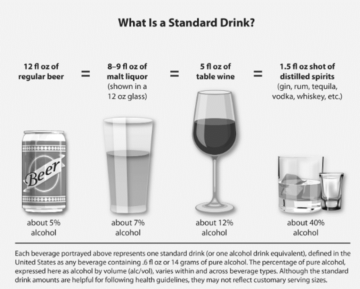Safe Alcohol Tips for St. Patrick’s Day (…and Every Day!)
Yes, it is fun to dress in all green and shamrocks, but let’s be honest. Most people look forward to St. Patrick’s Day for one reason: an excuse to drink green beer. It may feel good to relax and have a drink with friends, but with alcohol comes responsibility. As you drink, and your blood alcohol concentration increases, the more impaired you become. This can cause slurred speech, motor impairment, trouble concentrating, confusion and overall reduced inhibitions leading to risky behavior, motor vehicle and other accidents. This is true not only on March 17th, but each time that we choose to consume alcohol.
Drinking too much over time can take a serious toll on your health, and it is important to understand that no one should pick up drinking in pursuit of better health. While countless studies have promoted alcohol as safe and beneficial for health, a large global study published in The Lancet recognizes that the potential to develop cancer and other diseases offsets the touted benefits of moderate drinking for cardiovascular health ¹. The results from this study demonstrate that the safest level of drinking is none.
According to the Center for Disease Control, the economic costs of excessive alcohol consumption in 2010 were estimated at $249 billion ². Excessive and prolonged alcohol consumption has been associated with³:
Learning and memory problems; altered mood and cognition
Heart disease, hypertension, stroke
Fibrosis or cirrhosis of the liver; fatty liver
Pancreatitis
Many forms of cancer including head and neck cancer, esophageal cancer, liver cancer, breast cancer and colorectal cancer.
Alcohol dependence
So just how much is too much and what are some tips to ensure you are drinking safely?
If you do choose to consume alcohol, it is important to do so safely and know your limits. Let’s first start with the definition of a standard drink.
What is the difference between moderate and excessive drinking? How much alcohol is safe?
According to the "Dietary Guidelines for Americans 2015-2020,” U.S. Department of Health and Human Services and U.S. Department of Agriculture, moderate drinking is defined as up to 1 drink per day for women and up to 2 drinks per day for men. The American Cancer Society is also in line with this recommendation. The recommended limit is lower for women because of their smaller body size and because their bodies tend to break down alcohol more slowly. These daily limits do not mean it’s safe to drink larger amounts on fewer days of the week, as this can still contribute to various health problems. It is important to note that these guidelines do not recommend that individuals who do not drink alcohol to start for any reason.
The National Institute on Alcohol Abuse and Alcoholism (NIAAA) defines unhealthy alcohol use as drinking beyond recommended limits. They recommend that men drink no more than four drinks per day on any day or no more than a total of 14 drinks per week and women drink no more than three drinks on any day or 7 drinks per week.
Binge drinking on the other hand is defined by the NIAAA as a pattern of drinking that brings a person’s blood alcohol concentration to 0.08 grams percent or above. This typically happens when men consume 5 or more drinks or women consume 4 or more drinks in about 2 hours.
How do I know if I am drinking too much?
Alcohol abuse and addiction can be difficult to recognize. The CAGE questionnaire, developed by Dr. John Ewing, can be a helpful tool to identify if drinking may be problematic. The questionnaire includes the following 4 questions. If you answer yes to two or more of these questions, we recommend that you speak with your primary care provider.
Have you ever felt you should Cut down on your drinking?
Have people Annoyed you by criticizing your drinking?
Have you ever felt bad or Guilty about your drinking?
Have you ever had a drink first thing in the morning to steady your nerves or to get rid of a hangover (Eye opener)?
If I do choose to consume alcohol, how can I stay safe?
It is never too early to start thinking about this answer! Here are some of our tips to help you stay safe.
Plan ahead and make sure that you are prepared. This includes how much you plan to drink, who you will be with, and how you will arrange for transportation.
Make sure that you are well hydrated and have food in your stomach before consuming alcohol. Alcohol enters your bloodstream through your stomach and small intestines. Having food in your stomach will ensure that alcohol does not enter your bloodstream too quickly.
Beware of unfamiliar drinks and never accept drinks from strangers.
Try to avoid drinking games and shots as these will get you intoxicated rather quickly.
Pace yourself, especially if you are going to be drinking over several hours. Alcohol is dehydrating so it is a good idea to alternate alcoholic beverages with nonalcoholic drinks.
Know your limits! Your own limit may be a lot lower If you choose to drink, check in with yourself to register how you feel. If you do feel as if you may have had too much, ask a friend to help you get home safely.
Alcohol is a substance that should be taken seriously and cautiously. Drinking responsibly is important to keep both yourself and others safe. If you are concerned about your alcohol intake, it is always wise to check with your doctor who can help you formulate a plan.
Sources:
Alcohol use and burden for 195 countries and territories, 1990–2016: a systematic analysis for the Global Burden of Disease Study 2016 Lancet, 392 (2018), pp. 1015-1035
Center for Disease Control and Prevention (ww.cdc.gov)
National Institute on Alcohol Abuse and Alcoholism (niaaa.com)

